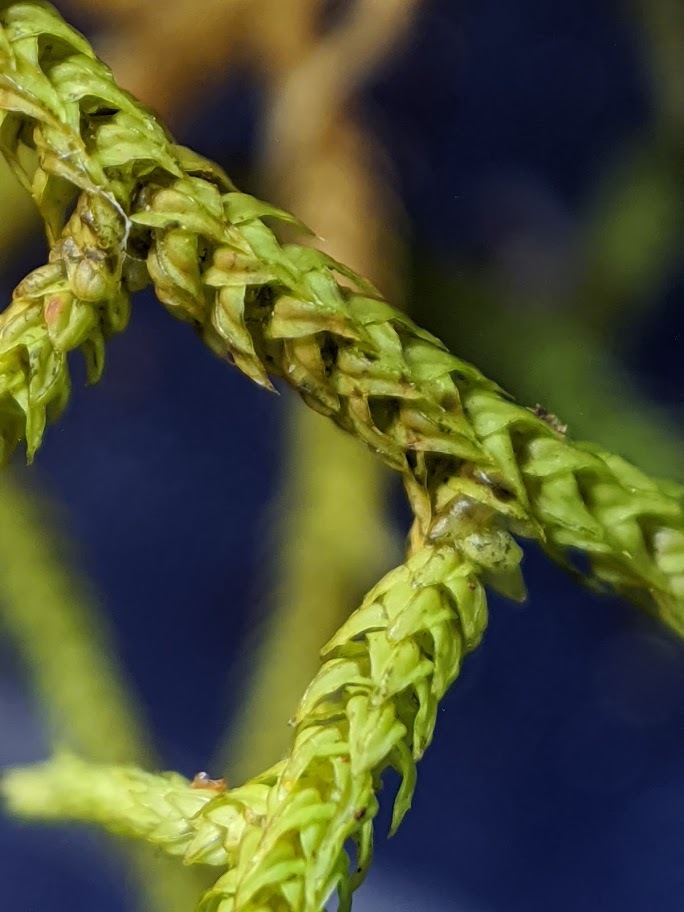Meteoriaceae
Dioicous or rarely autoicous (not in Victoria). Asexual reproduction by flagelliform branches and caducous leaves. Pendents, mats or wefts on trees or rarely rocks. Stems differentiated into creeping primary stems and pendent or rarely ascending (not in Victoria) secondary stems; primary stems with fascicles of rhizoids, with leaves similar to secondary stem or with scale-like leaves (not in Victoria); secondary stems distantly and irregularly branched or pinnately to tri-pinnately (not in Victoria) branched, with rhizoids in leaf axils and branch apices; paraphyllia absent; pseudoparaphyllia present, foliose, first pointing downwards and the other two situated at 120˚ to the first; central strand present or absent. Leaves arranged around the stem and facing all directions or complanate (not in Victoria), monomorphic or branch and stem leaves differentiated, ovate to lanceolate, appressed to wide-spreading when moist, rarely squarrose (not in Victoria), scarcely altered or more erect or appressed when dry, often decurrent and cordate to auriculate at base; apex acute, acuminate or apiculate, sometimes piliferous; costa single, terminating in basal to apical half of the leaf well below apex, or rarely absent (not in Victoria); margin plane (not in Victoria), recurved, erect or undulate, entire, serrulate, denticulate, serrate (not in Victoria) or dentate (not in Victoria), without a border or with a border of less papillose and sometimes more elongate cells; laminal cells often heterogenous in shape, size, wall thickness and papillosity across leaf, usually longest near base; mid-laminal cells rhomboid, elliptic or linear, uni- (not in Victoria) or pluripapillose and scattered over the lumen or in rows (not in Victoria) over the lumen or walls, or rarely smooth (not in Victoria); basal laminal cells often longer toward costa, quadrate, ovate, elliptic, rhomboid, hexagonal (not in Victoria), rectangular or linear, smooth or uni- or pluri-papillose; alar cells usually scarcely differentiated, or sometimes well-defined (not in Victoria), quadrate, hexagonal (not in Victoria) or rectangular, hyaline or coloured (not in Victoria) at insertion. Pleurocarpous. Seta smooth or rough (not in Victoria). Capsules erect or inclined, symmetric or rarely curved (not in Victoria), operculate, immersed (not in Victoria) or exserted, with or without (not in Victoria) an annulus. Calyptra cucullate or mitrate (not in Victoria), smooth, hairy or glabrous (not in Victoria). Operculum conic (not in Victoria) or rostrate. Peristome double and alternate; exostome of 16 entire teeth; endostome of 16 segments, often as long as exostome, without (not in Victoria) or with a high (not in Victoria) or low basal membrane; cilia absent, rudimentary, or present and well-formed (not in Victoria).
On all continents except Antarctica, with 21 genera and around 160 species; one genus and four species in Victoria.
A distinctive family of Pleurocarpous mosses distinguished by a combination of papillose laminal cells (except in very few non-Victoria species) and pseudoparaphyllia like in the Brachytheciaceae whereby the first to develop points downwards and the other two are situated at 120˚ to the first (Ignatov 1999; Huttunen & Quandt 2007). Most of the taxa, including the Victorian species, are also recognisable in the field by their pendent habit (Huttunen & Quandt 2007).
 Spinning
SpinningHuttunen, S.; Quandt, D. (2007). Phylogenetic relationships within the moss family Meteoriaceae in the light of different datasets, alignment and analysis methods, in Newton, A.E. & Tangney, R.S. (eds), Pleurocarpous Mosses: Systematics and Evolution, pp. 141–158. CRC Press, Boca Raton.
Ignatov, M.S. (1999). On pseudoparaphyllia in Brachytheciaceae and Meteoriaceae (Musci). Acta Botanica Fennica 165: 73–84.


